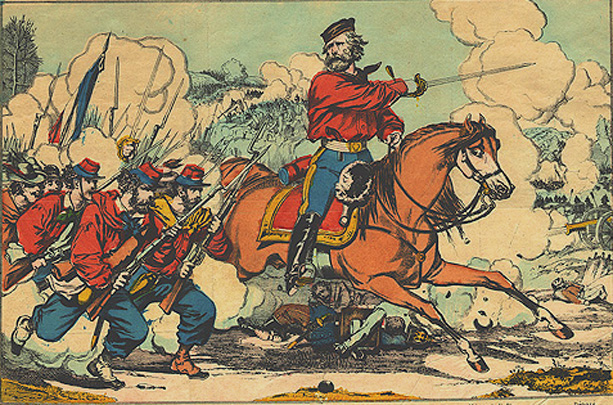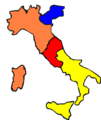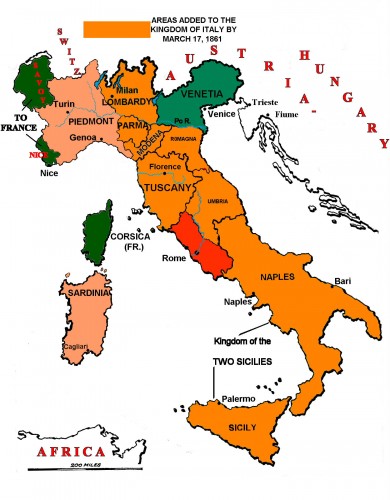Italy will spend 2011 celebrating the 150th anniversary of its unification – known as the Risorgimento (Resurgence). From a land of city-states, many under foreign domination, Italy became a country in 1861.
Most historians agree that the unification of Italy started in 1815 with the end of Napoleonic rule, but it took a tortuous path through the insurrections of the 1820s and 1830s and the abortive revolutions of 1848-1849. The War of 1859 created the Kingdom of Sardinia that encompassed most of northwestern and central Italy, including Tuscany. But the move to unify the peninsula stalled there. The rich north had had nothing to gain and little interest to take on the burden of the poor south or to confront the pope in the Papal States.

Giuseppe Garibaldi was the true hero who kick-started the final unification of Italy. In early 1860, he gathered about a thousand of volunteers (I Mille) in Genoa for an expedition by sea to Sicily.

The Kingdom of Two Sicilies (yellow on map), which ruled over not only the island, but most of the southern third of the mainland, had long been a corrupt government, oppressing a restive underclass. Although the Garibaldi Red Shirts were less skilled and ill equipped, they had tremendous success, gathering thousands of volunteers as they moved through the countryside. They occupied Sicily within two months. Garibaldi claimed Sicily in the name of Victor Emanuel II, King of Piedmont, Sardinia and Savoy. He then crossed to the mainland and marched his troops to Naples.
After Garibaldi’s success made full unification of Italy a real possibility, Piedmontese troops, under the command of Victor Emanuel II, used the riots and uprisings in the Papal States (red on map) as a reason to move south under the pretext of maintaining order. In 1860, two thirds of the Papal States joined the Kingdom of Sardinia and Rome was left alone. The Piedmontese army bypassed Rome and the remaining Papal States and marched south to Naples to help Garibaldi’s troops defeat the remaining armies of the Kingdom of Two Sicilies.

On September 18, 1860, Garibaldi gave up command of his army and all lands to the south, including Sicily and Naples, to Victor Emanuel II, signifying the unity and formation of the Kingdom of Italy, which was formalized by the new parliament on March 17, 1861. Victor Emanuel II was crowned the first King of Italy.
Although a Kingdom of Italy had been formed, it did not include all of Italy. The missing parts were Rome and Venetia. Venetia was annexed in 1866. Rome and the remaining Papal States became part of the union in 1870.
Throughout the year Tuscan Traveler will highlight events and stories relating to the unification of Italy.
